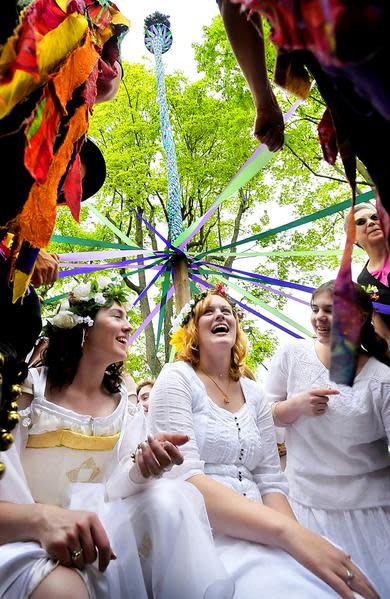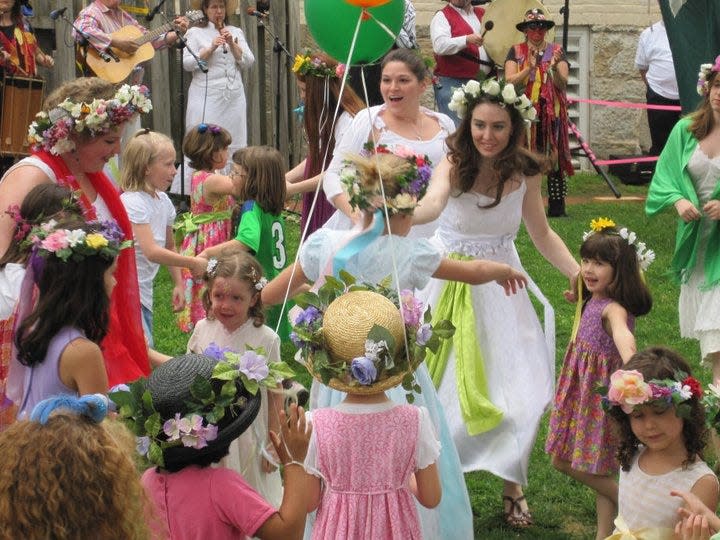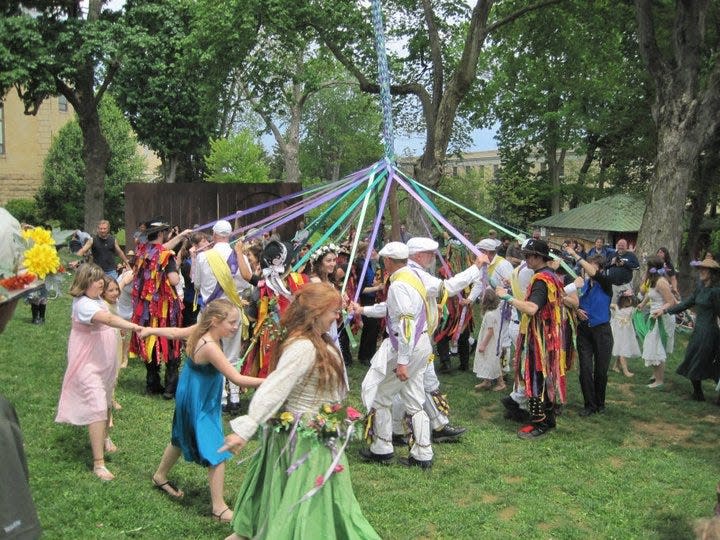Shake off those cold-weather blues and bring in the May!
"Tra la, it's May, the lusty month of May — That lovely month when everyone goes blissfully astray," chirps young Queen Guinevere as flower-bedecked maidens flirt and flit around the forest during her May Day celebration in "Camelot."
A little fanciful, perhaps, but while it might be lost on modern populations, May Day frivolity has a long tradition that goes all the way back to Rome.
And if you'd like to get a taste of Guinevere's fancies, head over to Shepherdstown, W.Va., where Upper Potomac Music Weekends and Shepherdstown Music and Dance are co-sponsoring the town's annual May Day celebration. Festivities are set from noon until about 1:30 p.m. on the lawn at Shepherd University's McMurran Hall.
It's been 28 years since the celebration became a Shepherdstown tradition.
Flowers and fertility
Floralia, a festival honoring the Roman goddess Flora (goddess of spring), was a precursor of May Day and lasted five days bridging the end of April and the beginning of May. The academic website Classical Wisdom notes the festival was "a time of dancing, gathering of flowers and the wearing of colorful clothes."
The Celts of ancient Britain celebrated Beltane, a pagan holiday marking the beginning of a new season. These ancients built bonfires to mark the beginning of the summer season, and it was this celebration that evolved into the medieval fetes known as May Day.
The May Day revelries were associated with fertility and new life. Villagers danced around maypoles, crowned a May Queen and followed a dancing character called Jack-in-the-Green (face painted green and head covered in leaves — aka the Green Man) in May Day processions.
Many of these traditions, including the 'Obby 'Oss — a tradition that comes from Padstow in Cornwall and features a dancer with a horse's head — will be featured during the Shepherdstown celebration.
"It's going to be opened by the Shepherdstown Piping Collective, three pipers that will pipe us to the maypole; and there will be a variety of dance and music performances," said Joan Blanton of Upper Potomac Music Weekends.
"We'll have the Padstow May song with the Padstow horse dancing around the maypole, with traditions of from the town of Padstow in England where the horse would dance throughout the town on May Day and young girls are supposed to touch the horse's skirt for good luck and getting married. But if they get caught under the skirt of the horse, they get pregnant," she added, laughing.
Toward the end of the Middle Ages, raucous May Day festivities ran afoul of the Church, and they were banned in 16th-century England — resulting, the historians at History-UK note, in riots that led to 14 executions during the reign of Henry VIII.
And during the Puritan leadership of Oliver Cromwell in the 17th century, even maypoles were outlawed.
But the celebrations returned with the restoration of the monarchy. King Charles II, in fact, set up a maypole in London that remained for half a century.
The Puritans who settled New England, however, frowned on May Day festivities, as a non-Puritan colonist quickly found out.

Thomas Morton, an English lawyer, settled in a community called Merrymount near what is now Quincy, Mass., with a number of indentured servants he'd accompanied to the colony. They hadn't gotten along well with straight-laced Puritans at Plymouth, according to the New England Historical Society, and set up their own little utopia.
In 1627, the colonists at Merrymount threw a May Day party, complete with maypole and dancing. And beer.
"Upon Mayday they brought the Maypole to the place appointed, with drums, guns, pistols, and other fitting instruments, for that purpose," Morton wrote, "and there erected it with the help of Savages, that came thither of purpose to see the manner of our Revels."
They enjoyed May Day partying with the Native Americans so much that in 1628, they did it again.
This time, Gov. William Bradford and Capt. Myles Standish had had enough. Morton was arrested and eventually sent back to England. That winter, Puritans raided Merrymount and chopped down the maypole.
Morton recorded his experiences in a book he called "New English Canaan," and, once back in England, actually got the Massachusetts Bay Colony's charter revoked. But the Puritans rejected the court order, and then the English Civil War broke out. The king who revoked the charter lost his head.
Two centuries after the May Day incident, the iconic Massachusetts writer (and regular critic of Puritanism) Nathaniel Hawthorne memorialized it in a short story called "The May-Pole of Merry Mount."
May Day celebrations had a resurgence in the United States during the victorian era, particularly on the campuses of women's colleges.

Workers unite
At the same time, notes the Smithsonian's Museum of American History, labor leaders were seeking reforms on behalf of exploited laborers.
On May 1, 1867, union workers in Chicago had a street party of their own to celebrate the passage of an 8-hour work day law in Illinois. The law was never enforced, however, and on May 1, 1886, 30,000 Chicago workers staged a strike.
And it spread.
After Chicago police fired into a group of striking workers — killing at least one; sources disagree on the actual number — laborers staged a protest in the city's Haymarket Square. Someone threw a bomb at police. Police fired back. Several on both sides were killed and scores were injured.
Four anarchists were eventually executed in what is now a disputed case.
The May 1 strikes won support across Europe, however, with a "great international demonstration" on May 1, 1890. For many, May 1 is still regarded as International Workers Day.
Bring in the May
While continued COVID-19 concerns have resulted in an abbreviated Shepherdstown celebration this year, organizers are packing a lot of tradition into Sunday's ceremony, which Blanton said will last until about 1:30 p.m.
"We have a group of local girls who have learned a garland dance, and they'll be dancing it under the maypole," she said, "and there'll be some Morris dancing(English folk dancing); there'll be a traditional 15th century French dance.

"And then it'll end with the wrapping of our 22-foot tall, wooden maypole in the center of town, where the audience is invited to participate by either weaving the ribbons or dancing around. There'll be some participatory singing and dancing also under the maypole."
Before COVID, the Shepherdstown event included a parade down German Street and a full afternoon of dancing. This year's event, however, concludes a weekend of activities that included a concert Friday evening, a dance workshop Saturday afternoon and a dance Saturday evening.
For more information, visit Upper Potomac Music Weekends' website at http://upmw.smad.us/
This article originally appeared on The Herald-Mail: May Day traditions of flowers and frivolity have ancient origins

